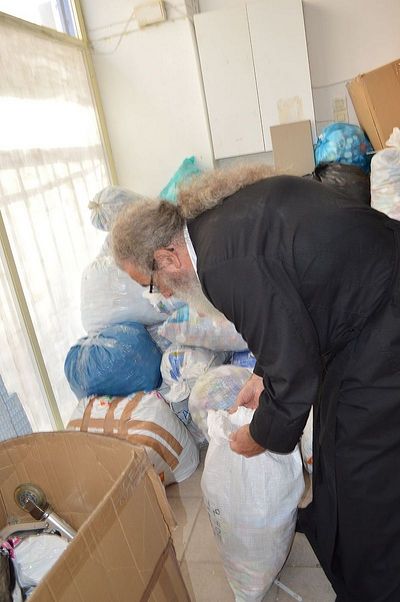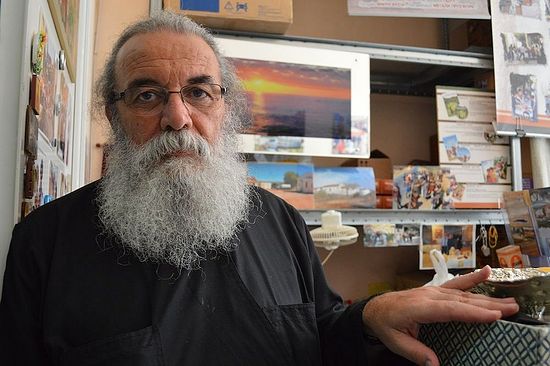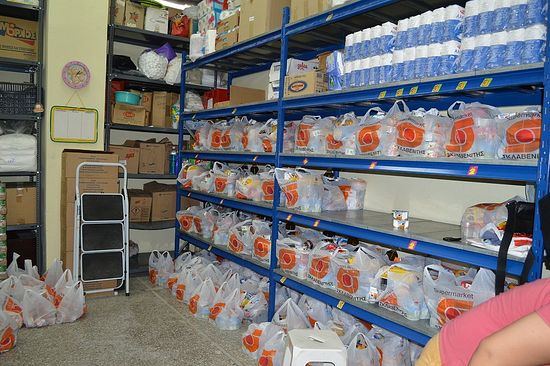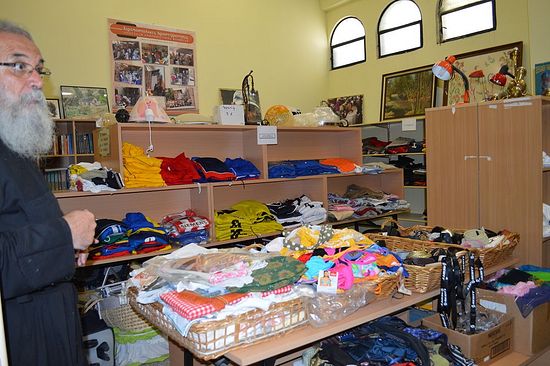In a non-descript, lower middle class section outside the port of Pireaus stands the cathedral of St Efthimios of Keratsini. On first glance it appears like so many neighborhood churches, looming in its red clay Byzantine shingles and arched doorways, a large fixture that calls those in its reach to worship as faithfully as the clock strikes the hours in its bell tower. But a side door on its right side, an entryway that one can walk by and totally miss, leads to an underground level that is teeming with an army of volunteers. In its subterranean level a nest of worker ants is buzzing with activity all in the name of philanthropy.
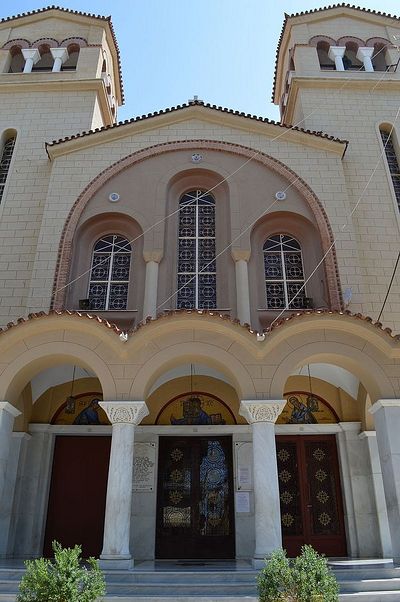 The facade of St. Efthimios in Keratsini; what looks like a normal, neighborhood church is bustling with a hive of do-gooders
The facade of St. Efthimios in Keratsini; what looks like a normal, neighborhood church is bustling with a hive of do-gooders Sacks filled with clothes and provisions lie neatly stacked on huge industrial shelves; knick knacks line the gift shop, selling everything from icons to soap, donations from lay people, supermarket surplus, or the remaining inventory of shop owners whose business closed due to the crisis. On first impression the church and its mission exude organization, a rare commodity in a country stereotyped as lacking in that department.
St Efthimios serves the double duty of providing for the needy in the surrounding parish as well as the needier in the remote countryside of Madagascar. In operating for 11 years now, St Efthimios serves as the head quarters for its mission in Madagascar. Father Constantinos, one of the priests in charge of coordinating the effort, when asked why Madagascar of all places replies, “It is important for a person in need to help. We have to pick one country to give to. If we have a chance to give, why not take it? The people in Madagascar are not different from us in Greece.”
History of the Mission
St Efthimios first started its missionary work by sending aid to India. Calcutta to be precise, where the Greek Orthodox Church ran an orphanage with 300 girls (the documentary “Tears of Love” by Christiana Thanos publicized the site). However, after the state of India refused to renew the visas of all missionaries to its lands, the philanthropic efforts were channeled to Madagascar, according the UN estimates, the poorest nation in sub-Saharan Africa. This occurred around the time when the fateful helicopter journeying close to Mt Athos that bore the Patriarch of Alexandria and the Archbishop of Madagascar exploded. This prompted the Patriarch to send the young Father Ignatios to expand the small mission in Madagascar in 2004. The headquarters for the relief has concentrated in St Efthimios’ four large warehouses since that time.
Work of the Mission in Madagascar
The Mission in Madagascar is a bustling reflection of the church’s efforts in Keratsini. Each year teams of volunteers visit the compound and help with construction, education, health care, theological training to some of the most impoverished peoples, mostly in the bush and far country, away from the main city. For example, every year a 6-member team from Cyprus including two internists, two dentists, and two pediatricians, run a 20-day healthcare program, visiting remote villages around the country, providing locals with the only visit they will get to a licensed healthcare provider the entire year. The mission not only runs an orphanage that takes in many out-of-wedlock babies through an chute door by its side, but has established a woodworking factory, an iron works shop along with aluminum welding factory. Most of the wood and iron supplies are shipped by containers from Pireaus every year as the local materials are quite expensive and of inferior quality. In this way the Mission has developed a nucleus of construction to build more needed buildings such as adequate houses for villagers, school houses, and health centers.
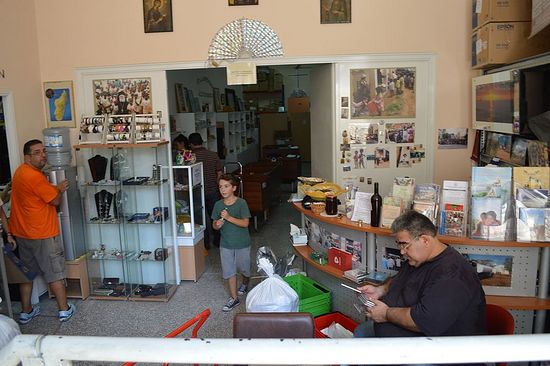 An underground door leads to the front of the thrift shop where voluteers are busy organizing supplies and tending shop
An underground door leads to the front of the thrift shop where voluteers are busy organizing supplies and tending shop The containers sent over by the work of volunteers from Keratsini have included cars, tractor trailers, medical equipment such as X-ray machines, wood beams, iron joists and steel pillars necessary for construction, in addition to food, clothing, school supplies, hardware, household appliances. The Mission sends from 2-3 containers annually, this year marking their 17th container to one of the most remote destinations in the world.
The volunteers in Madagascar include people from a broad spectrum of life: nurses, teachers, carpenters, lawyers, priests, theologians, social workers, etc. “We accept volunteers who are willing to work and not just tourists who want to use the mission as a base to go on holiday,” Father Constantinos explains. He asks that volunteers be willing to dedicate two months out of their lives to help. The Mission can accommodate up to 20 volunteers at one time as there are only so many seats on the jeeps to take them into the back country each day. He prefers that those thinking of volunteering to email their intentions first, go through a short Skype interview with himself or Bishop Ignatios, before they can get definitive approval. Because the summer months of July and August are high season for the volunteer supply chain, the Fathers would prefer to engage those willing to serve throughout the year, especially in the winter (when thanks to the equatorial flip they would enjoy hot summer weather instead of the Northern European or American cold).
The Work of the Mission in St. Efthimios
To generate revenue to support the Mission in Madagascar, St. Efthimios runs a thrift store. A team of volunteers sort and sift through bags and bags of donations, separating them into what is usable and not. These goods are distributed along with food and other necessities into burlap sacks that serve as care packages, each designated for a specific family in Madagascar.
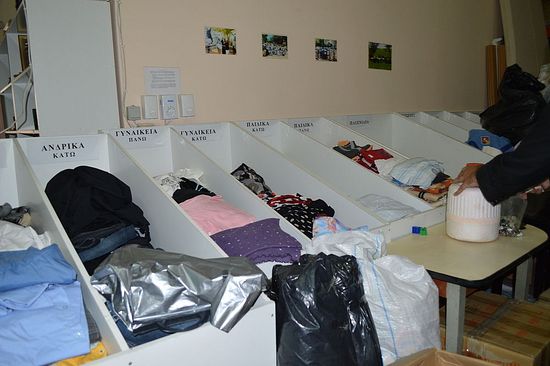 Volunteers sort out clothing into what is usable and what is not and place in cubbies. 150 volunteers take part in the Mission’s efforts.
Volunteers sort out clothing into what is usable and what is not and place in cubbies. 150 volunteers take part in the Mission’s efforts. The church also organizes fundraisers, but while other charities hold holiday fundraisers mostly around the Christmas or Easter holidays, the mission in Keratsini holds one every week. Word has gone out to the greater community, so that the needy in Athens and the surrounding suburbs can visit the shop for reduced prices on goods year-round. Neatly folded slightly used sweaters are stacked on shelves; slightly-used jeans can be had for 2 Euros as opposed to 25 in the going market. Everything from toys to baby supplies, feeding chairs, books, furniture, shoes, school supplies, hardware, light bulbs, lamps, paintings and decor–everything for the home can be purchased for under 5 Euros.
“This is very important for us,” Father Konstantinos attests, “because the store provides us with a needed source of income to fund our mission work. At the same time in this way the Mission for Africa has provided a step to help even the crisis in Greece.”
Dimitra Pallis, the social media volunteer who has worked at the Mission for 34 years, states that St. Efthimios has become a model of philanthropic logistics for other churches to replicate. It started before the crisis tending to the needs of 60 parish families but now serves 260. A retired teacher, Pallis devotes herself full-time to the mission. “I am working harder now then when I did in the job field,” she admits. During her interview, she was organizing the weekly food distribution for the needy and the unemployed on register: neatly packaged groceries in orange plastic Sklavenitis bags, just as you would find in a regular supermarket. She points to a young couple who dropped in to pick up their weekly rations.
“They are waiting on their second child,” she explains and because the mother has health problems we also supply the family with medication.” The parish is sponsoring and collecting funds for their marriage ceremony and the baptism of their first child. “We cater to the whole person,” Pallis states, “even bringing in social workers, plumbers, carpenters, whatever services are needed depending on the individual need.”
“Some of our volunteers are themselves unemployed,” she continues. “I feel that the mission has been set up to assist those who do the giving just as much as those who do the taking.”
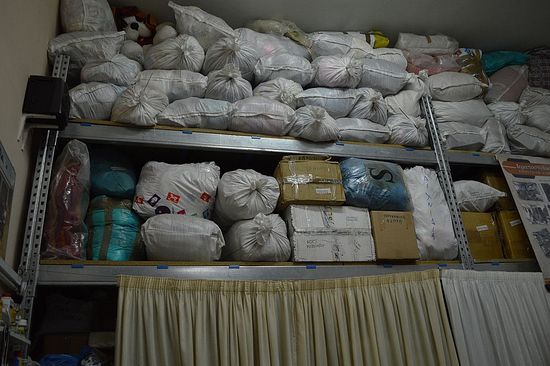 Stacks of supplies and goods wait neatly packed on the ceiling-to-floor shelves of one of the four storage facilities of the Mission
Stacks of supplies and goods wait neatly packed on the ceiling-to-floor shelves of one of the four storage facilities of the Mission The Church runs a tight ship. While it never turns away those who ask for help–providing free food, free clothing, free housewares–it does follow a thorough screening process. Families fill out forma and undergo a thorough background check to verify need. Visits to the shop operate by strict appointment schedule. This way much of the double-dipping from government aid that might happen is reduced. A team inspects documents and double-checks them against welfare lists; even house visits are arranged to verify the need. And donations are not distributed willy-nilly; they are checked against need, size, and quota.
To save on costs, the mission buys in bulk and wholesale. “Just today,” Father Constantinos confesses as he shows me a bill, “I spent 400 Euros for a month’s supply of marmalade.”
The Recycling Campaign
In one of its more progressive actions, St. Efthimios has undertaken a recycling arm to its fundraising efforts. Started in the last four years, it acts as a pickup point for old paper, cooking oil from restaurants, old appliances, construction and electronic supplies, wood, and plastic. The Church has done such a successful job in recycling that the “demos,” or public sanitation department has allotted a recycling container inside the church grounds. “The public employees work only until 3 pm,” Father Konstantinos explains, “but our volunteers labor around the clock. As a result, the Church has a better track record for recycling than the city.”
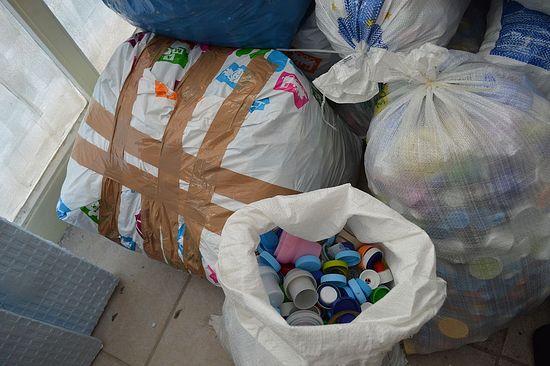 One of the most innovative recycling efforts of the Mission involves school children collecting plastic bottle caps. One and a half ton of plastic caps are collected and brought to recycling facilities.
One of the most innovative recycling efforts of the Mission involves school children collecting plastic bottle caps. One and a half ton of plastic caps are collected and brought to recycling facilities. Its most notable campaign involves the collection of the plastic bottle caps on the UHT cartons for milk, juice, and soft drinks, even detergent and fabric softener containers. Schoolchildren in the local area make an effort to collect these and bring them to school. One child can bring from 15 to 20 per day; with 500 children in a school, an average of 10,00 can be collected per day, amounting to 50,000 per week. Every week the church makes pick ups of these caps and after a ton and a half have accumulated, they pass it on to the local plastic recycling plant.
“We just break even with our recycling program,” Father Konstantinos said, “but we continue because it is a way for even the smallest of our members to contribute in some way to the larger good. We upkeep this campaign more for the feeling of accomplishment that we allow the giver, and not for the actual physical or financial gain in the practice.”
To date, the Million Cap Campaign has spread though the local public schools so that it has become a common habit among the children.
Post Script:
As a quasi-objective observer of this humanitarian effort, what struck me most is that in a nation ravaged by financial crisis and in need itself, people can still give out of their very need. It seems counter-intuitive but it seems that the more one needs, the more one gives. There is perhaps a drive or a need to give more in those who suffer want or need. Allegations of bigotry, racism and the rising tide of supremicist nationalism, the efforts of St. Efthimios, supported by Greeks of the Diaspora and within Greece itself, prove wrong in their very actions of philanthropy. In the words of Pater Konstantinos, “A human being has the same worth wherever he or she is–be it in England, or in Africa, or in Greece.” In the words of Dimitra Pallis, “If you want to give something you have to give to everyone. You cannot distinguish among people. For us it is not about giving to Greece over Africa. People who are practiced in giving give to everyone. Those who aren’t, don’t give to anyone.”

